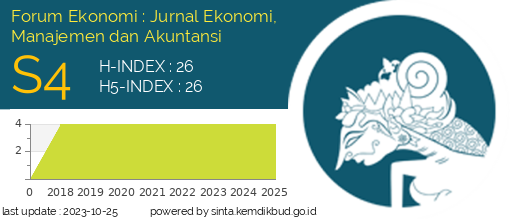Macroeconomic Impact on Population Density in Indonesia
DOI:
https://doi.org/10.30872/jfor.v27i1/3531Keywords:
Population density, Urbanization, Poverty, Income, Education, HealthAbstract
This research aims to determine and analyze population density by looking at the influence of poverty, income, education, health and urbanization in Indonesia. This research uses panel data regression with the variables poverty, income, education, health, urbanization and population density with data analysis using SPSS 22 software. The research period is 2020-2022. The results of this study show that poverty, education and health are significant to urbanization. Meanwhile, income has no effect on urbanization. Poverty, income and health are directly significant to population density. Meanwhile, education and urbanization have no direct influence on population density. The indirect relationship between poverty, income, education and health has no effect on population density through urbanization
References
Amjad, I., & Sumarno. (2020). Analysis of the Impact of Population Density on the Spread of Covid-19 in Bandung City. FTSP Series Proceedings, 2(2007), 2021. https://eproceeding.itenas.ac.id/index.php/ftsp/article/view/340
Bandiyo, S., & Indrawani, KF (2010). Overview of Rural Population Migration – Cities, Urbanization, and Their Impacts. Indonesian Population, 5(1), 41–56.
Damanik, RK, & Sidauruk, SA (2020). The Influence of Population and GDP on Poverty in North Sumatra Province. Journal of Darma Agung, 28(3), 358. https://doi.org/10.46930/ojsuda.v28i3.800
Dimmera, BG, & Purnasari, PDP (2020). Problems and Solutions for the Smart Indonesia Program in Realizing Educational Equity in Bengkayang Regency. Sebatik, 24(2), 307–314. https://doi.org/10.46984/sebatik.v24i2.1137
Jaya, I., & Fitanto, B. (2004). Economic Disparity between Regencies/Cities in Bali Province. Tera Journal of Accounting Science (TEMA), 5(1), 36–57.
Kumala, AZ, Agustini, HN, & Rais. (2013). Poverty Dynamics and Measuring Poverty Vulnerability in Efforts to Protect Children from the Impact of Poverty (Case Study of Households on Java Island 2008-2010). Child Poverty and Social Protection Conference 1, 1776, 610–627.
Mantra, IB (2007). General Demographics. Yogyakarta, Student Library.
Mu'awwanah, U., & Illah, GRR (2022). Indonesian Population Problems. Journal of Islamic Economics and Finance, 4(1), 75. https://ejournal.inaifas.ac.id/index.php/Al-tsaman/article/view/877
Paska, H.D. (2023). Indonesian Government's Efforts to Improve Health Services and Facilities in Rural Areas Regarding the Health Law. MAGISTRA Law Review, 4(01), 11. https://doi.org/10.56444/malrev.v4i01.3585
Rochaida, E. (2016). The Impact of Population Growth on Economic Growth and Family Prosperity in East Kalimantan Province. Economic Forum, 18(1), 14–24.
Sabitha, F.A. (2022). Analysis of the Influence of the Level of Urbanization on the Availability of Residential Land in the City of Surabaya. Lemhannas RI Journal, 10(1), 19–26. https://doi.org/10.55960/jlri.v10i1.268
Sheyoputri, ACA (2016). Regarding and Understanding Poverty. Jakarta: CMB Press.
Sidabutar, N.V., & Chotib, C. (2021). The Relationship between Migration and the Quality Level of Household Sanitation Facilities in Jakarta: Analysis of 2017 Susenas Micro Data. Indonesian Population Journal, 15(2), 165. https://doi.org/10.14203/jki.v15i2.534
Suffina, L., Budi, R., & Suharto. (2022). Factors influencing urbanization in Samarinda. Online) PERFORMANCE: Journal of Economics And Management, 19(1), 37. https://doi.org/10.29264/jkin.v19i1.10855
Sugito. (2016). Implementation of the Transmigration Policy in Pangmilang, Singkawang City, West Kalimantan Province. (PROJECTION of the Journal of the Social Sciences and Humanities PROJECTION of the Journal of the Social Sciences and Humanities (e-Journal)), 19(1), 43–54. https://doi.org/10.26418/projection.v19i01.923
Syifa, S., & Nasution, N. (2023). TALENTA Conference Series Analysis of the Effect of Urbanization, Per Capita Income and Manufacturing Industry on the Economic Growth of North Sumatra. LWSA Talent Conference Series, 06. https://doi.org/10.32734/lwsa.v6i1.1703
Tambaip, B., Tjilen, AP, & Ohoiwutun, Y. (2023). The Role of Health Facilities for Community Welfare. Journal of Public Policy, 14(2), 189. https://doi.org/10.31258/jkp.v14i2.8245
Xing, Z., Cheng, C., Yu, Q., Yang, J., Ma, H., Yang, J., & Du, X. (2022). Informal Community Growing Characteristics and the Satisfaction of Concerned Residents in Mountainous Urban Areas of Southwest China. International Journal of Environmental Research and Public Health, 19(22). https://doi.org/10.3390/ijerph192215178
Yunianto, D. (2021). Analysis of population growth and density on economic growth. Economic Forum, 23(4), 688–699. https://doi.org/10.30872/jfor.v23i4.10233
Zulfiyah, I., & Imron, A. (2017). Urban Poor Communities in Kali Barat Jaya Stren, Surabaya. Paradigm, 5(3), 1–6.
Downloads
Published
Issue
Section
License
Copyright (c) 2025 Anggi Somba Poddala

This work is licensed under a Creative Commons Attribution-ShareAlike 4.0 International License.






